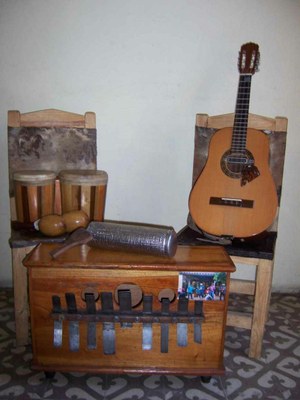11.3.1 Changüí /Changüí-Son.

Changüí is the musical genre that most closely resembles son; it originates from the easternmost region of Cuba and can be classified as the legitimate nucleus of that musical genre. Changüí’s origins in Guantánamo date back to the 19th century.
Its beginnings are framed in a socio-historical context 1871-1899. Its (2/4) time signature with lyrics of the songs witty according to the singer’s inspirations, the copla or the expression made by the members of the group in unison and the montuno where a soloist leads the way, performing improvisations alternating with the chorus that corresponds to the refrain.
The instrumental ensemble used for its performance consists of five instruments: three, a marímbula, a bongo, a güiro, and maracas. Its structure consists of two sections: the copla, or exposition performed by all members of the group in unison, and the montuno, where a soloist leads the way and improvises, alternating with the chorus, which responds to the refrain. The lyrics of its songs reflect everyday events, are satirical, or can also be humorous.
Changüí is not only a very specific type of music, but also a form of popular interfamily celebration with music-verse, dance and fun, a relationship between gesture and music, and even a psycho-musical and cultural expression rooted in customs and a way of life that typifies rural-urban areas of Guantanamo.
Many figures have been highlighted in past centuries and live on within Guantanamo folklore, among them Nene Manfugaz, who was one of the first figures to learn about the history of this Cuban musical genre and other sound forms, bringing them to Santiago de Cuba in 1892.
Also notable are Juan Mosqueda, Julín Núñez, Pedro Masé, Marcelino Latamblé, Juan Logás, Benjamín Castellanos, Raúl Carpe, Chito Latamblé who contributed greatly to this musical genre. Rogelio Lascalle, Tunto Gainza and Maía Guevara. Also Julian Balier, Guillermo Mustellier, Bula, Nina Mendoza, Herminia García Wilson, Boy Carmelo Gilbert, Marcelino Hipólito Danant Sinclait, Geovanis Rodríguez, Racife Duran (the Guajiro of la Cidra), Chicho Ibáñez, Miguel Martinez, Eduardo de Vicet, Juan Vicet, Juan de Dios Duany, Luis Odio, Antonio Roble, Juan de Dios Antemachín (the famous Cotó) and other prominent figures such as Elio Revé Matos, who is considered the Father of changüí.
In Havana, Elio Revé introduced this style of sounding, montuna, and peasant music in 1958, when he founded his first orchestra at the Allec cabaret. He fused Changüí with Son, which became known as the fourth phase of instrumental ensembles. This opened a new era when Elio brought rhythmic and formal elements from Changüí to Son, naming it Changüí-Son. While living in Guantánamo and playing with the Armonía orchestra before 1955, he already expressed interest in developing this Cuban musical genre.
In Havana, the Elio Revé Orchestra continues to develop contemporary Changüí, led by his son, Elito Revé, since Maestro Elio’s death. Elito Revé carries on his father’s legacy, thanks to which this Cuban rhythm is known worldwide.
Elio Revé is a figure who transcends the musical universe, thanks to whom this genre became known in Havana, Cuba, and the world. Any historical chronology of Son in Cuba must include the figure of Maestro Elio Revé, the father of Changüí.








